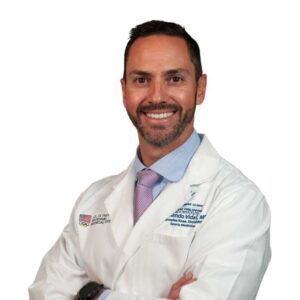What is AC joint pain?
The acromioclavicular joint, also called the AC joint is located at the top of the shoulder where the highest part of the scapula, called the acromion, meets the clavicle (collarbone). You can feel your AC joint on the outside and top of the shoulder. There are many conditions that can cause AC joint pain, the most common are fractures, separations and arthritis. Trauma, separations, or the loss of cartilage in the AC joint, can cause pain, swelling and limited range of motion. Dr. Armando Vidal, orthopedic shoulder specialist, treats patients in Vail, Aspen and the surrounding Denver, Colorado communities who are suffering from AC joint pain.

What is AC joint arthritis?
Pain and tenderness at the top of the shoulder or difficulty reaching the arm across the body—to put on a seat belt, for example—may be a sign of acromioclavicular arthritis. In fact, arthritis in the AC joint in the shoulder is more common than arthritis in the glenohumeral joint (ball and socket joint) in the shoulder. Arthritis in the shoulder is typically indicated by a gradual onset of pain, tenderness and limited range of motion. Acromioclavicular arthritis comes in many forms, most commonly osteoarthritis, followed by forms of inflammatory arthritis, such as rheumatoid arthritis.
What causes AC joint pain?
The most common cause of chronic AC joint pain is arthritis. Arthritis in this particular joint in the shoulder is more common, but the exact cause of acromioclavicular arthritis is unclear. Patients in Colorado who develop AC joint arthritis can have one or more of the following traits in common:
- Joint Trauma – Severe injury can lead to acromioclavicular arthritis months or even years after the injury.
- Joint Stress and Chronic Injury – Repetitive movements, especially overhead can cause mini-trauma within the joint, making it more susceptible to arthritis.
- Congenital defect – Poor bone alignment, metabolic disorders or episodes of septic arthritis can increase the chance of osteoarthritis in this joint.
- Advanced age – Often called “wear-and-tear” arthritis, the articular cartilage in the joint can break down and wear away, leaving bone-on-bone rubbing, with will cause osteoarthritis.
- Family History – Genetics can influence the risk of developing arthritis.
How is AC joint pain and arthritis diagnosed?
Dr. Vidal can usually diagnose AC joint arthritis with a careful physical examination. He may utilize x-rays to evaluate the joint and to see if there is degeneration, bone spurs or narrowing of the AC joint. If soft tissue damage is suspected, an MRI scan may be needed to determine the extent of damage and to formulate the best treatment plan.
What is the treatment for AC joint arthritis?
Acromioclavicular osteoarthritis (AC joint arthritis) is a progressively degenerative disease that cannot be reversed; however, a few steps may be taken to slow the degenerative process and control pain.
Non-Surgical Treatment:
- NSAIDs – Non-steroidal anti-inflammatory drugs may help alleviate pain in the joint.
- Activity Modification – Activities that cause pain in the AC joint, or which make the condition worse, should be avoided.
- Warm or cold compress – Applied to the AC joint can help with pain and tenderness.
- Physical Therapy – Strengthens the surrounding muscles, taking stress off of the joint.
Surgical Treatment:
If AC joint osteoarthritis symptoms are severe and non-surgical treatments have failed to provide pain relief and restore range of motion, Dr. Vidal may suggest surgery. Thankfully surgery to address AC joint pain is very established and typically has a very straightforward recovery and post-operative course.
- Distal Clavicle Excision – removes a small portion on the end of the clavicle which can eliminate the friction between the clavicle and the scapula. This can be done arthroscopically or open depending on the clinical context.
How long is the recovery after surgical treatment of AC arthritis?
95% of Dr. Vidal’s patients who undergo arthroscopic surgery for AC joint arthritis have excellent pain relief results. In general, patients who follow through with their post-operative physical therapy and protocol, return to sports and work in as little as 3 months.
Shoulder Arthritis Specialist
AC joint pain have a number of causes, including arthritis, trauma, and age. Regardless of the cause, AC joint pain can be treated many ways, with or without surgery. Shoulder specialist, Doctor Armando Vidal provides diagnosis as well as specified treatment plans for patients in Vail, Aspen, and the surrounding Denver, Colorado communities who are experiencing shoulder pain or arthritis. Contact Dr. Vidal’s team today!

Locations
180 S Frontage Rd W
Vail, CO 81657
226 Lusher Court
Ste 101
Frisco, CO 80443
322 Beard Creek Road
Edwards, CO 81632


